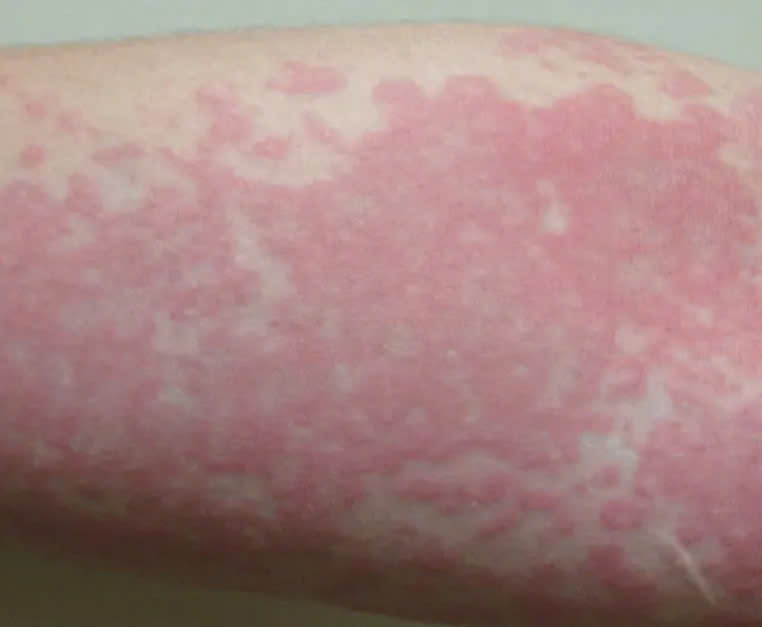Urticaria—commonly known as hives—is a skin condition that affects nearly one in five people at some point in their lifetime. For many, the sudden appearance of itchy, raised patches on the skin can feel frightening or confusing, especially when they arrive without warning. These patches, known as weals, can vary in size and shape. Some are small and round, while others form ring-like patterns or join together to create larger areas of irritation. Although the markings themselves may look alarming, urticaria is usually a temporary reaction that the skin eventually recovers from. Still, understanding the condition, what triggers it, and how to manage it can make living with hives far less stressful.

These weals often appear after scratching or rubbing the skin, though they can arise spontaneously even without irritation. They can show up on any part of the body—the arms, legs, back, face, or even the scalp. Because urticaria can appear so quickly and so visibly, many people worry that it may signal something serious. For most individuals, however, the reaction is brief and manageable.
At the root of urticaria is the release of histamine and other chemical mediators into the bloodstream. These substances come from mast cells, which are part of the body’s immune system. When histamine is released, it causes tiny blood vessels in the skin, called capillaries, to leak fluid. That fluid collects in the tissues just under the skin, creating the raised welts that most people associate with hives. Even though the welts look dramatic, this process is simply the body’s natural response to irritation, allergens, or other triggers.
While the hive-like patches usually fade within 24 hours, the underlying condition can linger for days, weeks, or even longer. In many cases, urticaria is accompanied by another symptom called angio-oedema. This condition causes swelling beneath the surface of the skin, typically affecting softer, more delicate areas such as the eyelids, lips, hands, feet, or inside the mouth. Unlike the itchiness associated with hives, angio-oedema usually feels more painful or uncomfortable. It may also take longer to resolve, sometimes lasting for several days before the swelling fully disappears.
If swelling occurs without the typical weals seen in urticaria, doctors may consider the possibility of hereditary angio-oedema. This is a rare genetic condition unrelated to hives and requires a different type of evaluation and treatment. Blood tests are usually needed to diagnose hereditary angio-oedema, and because it can be more serious, medical care is essential if swelling appears without any accompanying rash.
Urticaria itself is categorized into several types based on how long symptoms last and what triggers them. Understanding these categories can help people recognize patterns and seek appropriate care.
The first and most common type is Acute Urticaria, which typically lasts less than six weeks. In these cases, the cause of the outbreaks is usually identifiable. Common triggers include allergic reactions to foods like nuts, shellfish, or eggs; certain medications; insect stings; or exposure to environmental allergens such as pollen or pet dander. Because the trigger is often easier to pinpoint, acute urticaria is generally easier to treat and resolves more quickly than other forms.
The second category is Chronic Urticaria, defined by symptoms lasting longer than six weeks. With chronic cases, the exact cause of the outbreaks is often unknown. Many people experience persistent hives without ever discovering the precise trigger. This type can be frustrating because it may flare up unpredictably, sometimes daily or weekly. Even though chronic urticaria can last months or years, it is still manageable with proper medical care and lifestyle adjustments.
The third type is known as Physical Urticaria, which occurs when external factors create a reaction on the skin. Common triggers include scratching, pressure from tight clothing, exposure to cold temperatures, sunlight, heat, or even an increase in body temperature during exercise. Some people also experience hives after taking a hot shower or stepping into direct sunlight.
Although the appearance of hives can be unsettling, most cases do not require medical treatment. In many situations, the rash fades on its own within a day, leaving no trace behind. However, for individuals who experience ongoing discomfort or frequent outbreaks, doctors may recommend medications that help reduce symptoms. Antihistamines are the most common option, as they block the effects of histamine and help calm the skin’s reaction. When symptoms are more severe, a doctor may prescribe steroid tablets for short-term use or suggest menthol-based creams to ease itchiness.
Managing urticaria often involves identifying and avoiding triggers when possible. Keeping a journal of foods eaten, activities, and environmental exposures can help uncover patterns. For those experiencing chronic or recurrent hives, a visit to a dermatologist or allergist can provide valuable guidance. Some individuals may require allergy tests or additional blood work to rule out underlying conditions.
For people dealing with physical urticaria, simple preventive steps—such as wearing loose clothing, avoiding extreme temperatures, or taking cooler showers—can significantly reduce flare-ups. Stress management is also helpful since emotional stress is known to worsen symptoms in many individuals. Gentle skin care can also make a difference. Using mild soaps, avoiding harsh lotions, and protecting the skin from friction may help prevent irritation.
While urticaria can be inconvenient and sometimes uncomfortable, it is a condition that most people learn to manage effectively with time and care. The important thing is understanding how the body responds, paying attention to potential triggers, and seeking medical advice when symptoms persist or worsen. With proper treatment and awareness, individuals can reduce the frequency of outbreaks and improve their comfort and quality of life.
If you or someone you know struggles with recurring hives, remember that help is available—and understanding the condition is the first step toward relief.
Please SHARE this article with your family and friends on Facebook.





